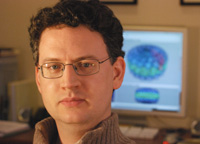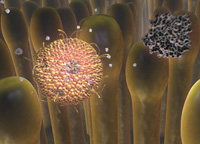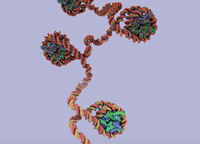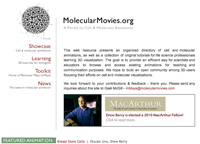« Prev Next »
 In today's podcast, Ilona talks to Gael McGill, Director of Molecular Visualization at Harvard Medical School and CEO of Digizyme. While earning a PhD in Cell and Molecular Biology at Harvard Medical School, Gael recognized a need for scientifically-informed design that would support both the communication and analysis of scientific ideas. To meet this need, he began Digizyme, a scientific animation and design studio that supports scientists in biotech, pharma, and academia to help them create animations of molecules. These animations incorporate actual measurements of molecular structure and movement, and therefore depict their authentic function and process. Together with his team at Harvard, Gael creates molecular animations and does research on how to best design visual media for science and education. Gael is currently applying his talents and research results as Digital Media Director for the Life on Earth Project, spearheaded by E. O. Wilson, which aims to develop an interactive digital biology textbook that will be free and available to all. Until then, we can enjoy his ongoing effort to select and disseminate molecular animations with a high teaching value in the ever-growing collection of animations at MolecularMovies.org. [15:27]
In today's podcast, Ilona talks to Gael McGill, Director of Molecular Visualization at Harvard Medical School and CEO of Digizyme. While earning a PhD in Cell and Molecular Biology at Harvard Medical School, Gael recognized a need for scientifically-informed design that would support both the communication and analysis of scientific ideas. To meet this need, he began Digizyme, a scientific animation and design studio that supports scientists in biotech, pharma, and academia to help them create animations of molecules. These animations incorporate actual measurements of molecular structure and movement, and therefore depict their authentic function and process. Together with his team at Harvard, Gael creates molecular animations and does research on how to best design visual media for science and education. Gael is currently applying his talents and research results as Digital Media Director for the Life on Earth Project, spearheaded by E. O. Wilson, which aims to develop an interactive digital biology textbook that will be free and available to all. Until then, we can enjoy his ongoing effort to select and disseminate molecular animations with a high teaching value in the ever-growing collection of animations at MolecularMovies.org. [15:27]
![]()



Full transcript
ILONA MIKO: Welcome to the latest edition of NatureEdCast. I'm Ilona Miko, and today we're talking to Gael McGill, Director of Molecular Visualization at Harvard Medical School and CEO of Digizyme. While earning a PhD in Cell and Molecular Biology at Harvard Medical School, Gael recognized a need for scientifically-informed design that would support both the communication and analysis of scientific ideas. To meet this need, he began Digizyme, a scientific animation and design studio that supports scientists in biotech, pharma, and academia alike to help them create animations of molecules. These animations incorporate actual measurements of molecular structure and movement, and therefore depict their authentic function and process. Together with his team at Harvard, Gael creates molecular animations and does research on how to best design visual media for science and education. As part of a full-fledged effort to apply the fruits of this kind of work to the greater good, Gael is also Digital Media Director for the Life on Earth Project, spearheaded by E. O. Wilson, which aims to develop an interactive digital biology textbook that will be free and available to all. Welcome, Gael.
GAEL MCGILL: Well, thanks for having me.
MIKO: So, can you tell us a little bit, what is data visualization, and what can we learn from it?
MCGILL: Sure. So, I think broadly speaking, I would reduce that to bio-visualization, which is the specific area that my activities are focused on. And I think of it as a way to understand nature by creating images or movies of it. So there are many ways in which the processes of nature remain hidden from us, either because the structures are so infinitely small or because the processes happen on timescales that are beyond the reach of the human senses, whether it's the incredibly rapid conformational changes of a protein or whether it's changes that happen on ecological or evolutional timescales — to me bio-visualization is an opportunity to make those changes visible and to reveal those structures and processes to the audience in an intuitive and visual way. And so I think the other thing about visualization that I like think about is that it's actually — there's quite a variety of projects. I think of it as a continuum of activities. On the one end of the spectrum, you have the use of animation and multimedia to communicate and for educational purposes. These are usually very narrative-driven movies and you're telling a specific story. And so I think that's the traditional way we think of science animation. But at the other end of the spectrum, you also have the use (often using the very same software tools) of visualization to look for answers or patterns in raw data. And here you're using it more as a discovery tool, and really just to formulate new hypotheses. So my groups actually create projects at either end of the spectrum, whether it's an outreach movie for the Boston Museum of Science or WGBH, all the way to the other end, such as creating accurate visualizations for colleagues at Harvard Medical School. So anyway, it's an exciting field. It's more than pretty pictures. We try to be as accurate as we can, and it's an opportunity for knowledge synthesis, I think, in biology as well.
MIKO: So how do you make these animations? And specifically, what is the form of the information you use to create such detailed and authentic animations?
MCGILL: Well, so you might expect that specialized software coming out of the research community would be really what's used in this case. But actually, there's a recent trend where people have been looking to the entertainment and gaming industries and to borrow from essentially what has been billions of dollars of investment in software development. So this is the Hollywood-type software that they've used to create any of the Pixar movies or Star Wars or Avatar. Those are incredibly powerful software animation and simulation suites, and in particular the one that we use, and one of the more established packages is called Maya, which is made by Autodesk. The thing is, those packages were never meant, really, to animate biological data or even to import it. So we wanted to build upon the power of that software and give it the ability to directly import scientific data, and thereby increase the accuracy. So a few years back, we created a new software called Molecular Maya that sits on top of Maya and lets you animate and import molecular — and it's not just molecular, also cellular data — there's really no limit, in a sense, to where we can gather the data for these movies. We do start a lot of times from the PDB, the Protein Databank, or the EM databank for electronic microscopy. So those are the, those are the tools and the sources, but I would just add that I think even more important is to start with an interest for developing accurate animations, which has not always been, I think, the priority in science movies, at least ones driven by marketing dollars. So, you know—
MIKO: Yes, well, making beautiful pictures is often, goes a long way, yeah — whether they're accurate or not.
MCGILL: Right. Yeah, and actually, knowing how to find the right data, as well. I think those are challenging things. It's one of the reasons why everyone on my team is a scientist by training. I think it's important to be passionate about the science that you depict, and the aesthetics of the movies serve the content, rather than being kind of eye candy for its own sake.
MIKO: And apparently using them, you can use these in ways to find out about how students learn. So I'm curious here, your team recently completed a research project that tracked students' understanding of the biological processes they observed in animations, and they also used — you also used eye tracker recordings to follow what components of an animation an eye dwelled on and spent the most time with. Can you tell us a little bit about that project and the results you found?
MCGILL: Sure. So in addition to our visualization and software development efforts, we're very interested in how the design of an animation has an impact on how students learn the science, and there's a lot of talk about the potential for multimedia engaging students, and in certain cases, I think of it almost as buying attention credits. But actually we're interested in pushing that further. We would really like to know how the design of a scientific animation can directly be connected to knowledge transfer. What is the best way to use these tools for maximal pedagogical impact? So the experiment itself is to take a very simple, in this case a very simple molecular binding event, a ligand is binding a receptor. But what we did is, we created that short theme in four different versions. And I can briefly describe those versions. Version one is where the ligand and the receptor meet in a very predictable way, let's say. The ligand flies in, lands very smoothly on the receptor as if it new exactly where it was going, there are no additional proteins in the environment, there's no particular internal motion (in other words, the proteins are dealt with as rigid bodies), and it overall looks like a very controlled process. Version two has the same actors, let's say, in the movie, but we have random motions on both so that you don't really have a sense that the ligand knows where it's going. Version three is identical to version two, except that we add molecular crowding in the environment, so a lot of other proteins bumping around. And version four is the same as version three, but we add even more visual complexity, where now we're showing actual molecular water and it's actually a complete mess, visually, but one in which the student can still follow the ligand and the receptor binding event.
So we have 200 students. We break them into four groups. Each group sees a different animation. They get a test before they see it; they get a test right afterwards. And they also have a test two weeks later for long-term memory. And then for some of the students, as you mentioned, we also have eye tracking data, so we know exactly what the students were looking at as they viewed the animation. And in a nutshell, what we found is that perhaps surprisingly, the students who were exposed to the more complex versions, visually-complex versions, tend to do quite a bit better than students who were exposed to the simplified versions. And I think the reason why I'd find that quite interesting is that it tells us that if the animation is cleanly designed, if you still can pull out the main event of the ligand binding, you can add all kinds of additional motion (and in this case crowding, let's say, of the environment) that gives students an intuition for how molecular environments may behave. And that type of information carries across the entire curriculum. It's no longer about, does A bind B. It's about having an intuition for Brownian motion or diffusion or things that we need to start thinking about embedding in the design of our animations. So we're very excited by this preliminary data, and I think quickly some obvious next steps to us relate to research that's been done, where we know that sometimes a movie, even a beautiful and accurate movie, that plays at you is not enough. You need to engage students. You need to trigger their ability to ask questions and even make mistakes. It's a, learning is an iterative process, and a lot of this comes out of kind of the inquiry-based learning field. So we've been looking at ways to give students control over dialing in and out the visual complexity of the animations interactively. So that it gives them the ability to essentially scaffold their understanding of the process — if they can dial in some of these additional, more complex visual layers. And even better, and I'll end on that for this question, is the idea that they might able to control a simulation of the binding event in real time, and actually we've started to create those tools as well. So it's not just about dialing in the visual complexity, but about changing the temperature, the concentration, so that they find conditions where the binding event may never even occur or they discover on their own what are the best parameters to allow the binding event to happen. And I think that would be an exciting thing to test.
MIKO: So this is like a very complex dimensional interactive, as opposed to a very 2D interactive, which is the popular form these days, where the student can remove action in the animation and see how that action actually affects the focus of the animation, which is really interesting. And I think that does really blend well with the inquiry based strategies that many people advocate now in science ed. What I'm curious about is, do you see this kind of — obviously this is a very labor intensive work — do you see this kind of science instruction becoming more popular? And do you see it as a trend increasing in science education in general?
MCGILL: I think that it's definitely a field in full expansion right now. I think scientific animation itself has been around for a little while. So that in itself is not really what's new. What may be new and improving is the care and accuracy with which these are created. And I think that comes not only from better tools, but also there's kind of a new generation, I think, of scientist animators, of people who have not only a command of the content but also the technical capabilities to pull off these high-end animations. So in that sense, I think, there's a new trend. And I'm involved in the creation of a new digital biology textbook, E. O. Wilson's Life on Earth. And I mention that, because it's been a great platform to test and develop our visualization skills and to be more proactive, basically, about putting some of these design principles into practice. So the focus, again, is not just to engage the students, but with the existing team that we have, and with this project, it gives us the ability to ask for every nugget of information: What is the best approach to teaching that one concept? It's no longer the idea that you write 1,000 pages of a textbook, and almost as an afterthought, you think of an art program. You think of developing figures for it. This is a bit of a new process where we can ask ourselves for every concept that we're teaching: What's the most efficient way to teach that? It may still be just a paragraph of text in certain cases. But in other cases, it may be a static diagram or an interactive diagram or an animation or even just a video interview with a charismatic scientist. So I think because we have all of these techniques in our toolbox, we're really excited to be embarking on this new project. And you know, in general, it's just a very exciting field to be in. Bio-visualization gives you an opportunity to combine not only your passion for science and your love of biology, but also it's quite technical in the way that you would implement these. So that combined with any artistic tendencies you might have, it's really an exciting field to be in at the moment.
MIKO: Well, thanks, Gael, for telling us about that today, and thanks for joining us.
MCGILL: Thank you.
MIKO: Thank you for listening to this edition of NatureEdCast. You can find this podcast and others at nature.com/scitable. That's nature.com/s-c-i-t-a-b-l-e. Please join us again next time.






















